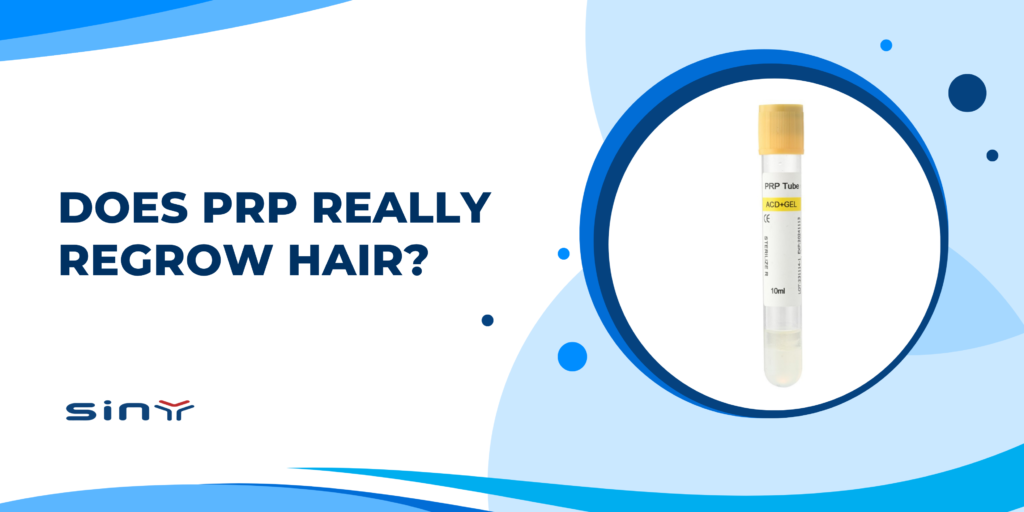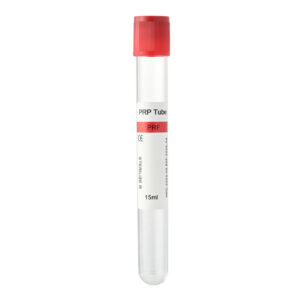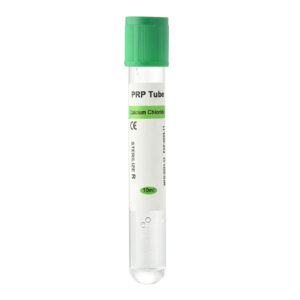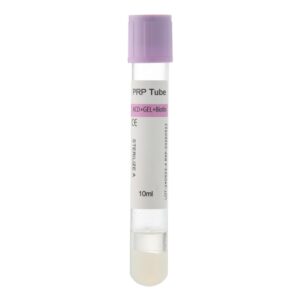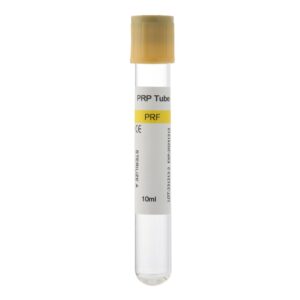Does PRP Really Regrow Hair? In the evolving landscape of regenerative medicine, Platelet-Rich Plasma (PRP) therapy has emerged as a prominent non-surgical option for hair restoration. The central question for clinicians and distributors alike remains: Does PRP really regrow hair? The growing body of scientific evidence points towards a positive answer, but with a significant caveat—the effectiveness of the treatment is profoundly linked to the quality of the PRP preparation, which begins with the PRP tube itself. This guide explores the science behind PRP for hair regrowth, examines the critical factors that determine its success, and guides you in navigating the market to source high-quality products.
What is PRP therapy?
PRP therapy leverages the body’s innate healing mechanisms to stimulate hair growth. The procedure involves drawing a patient’s blood, processing it to concentrate the platelets, and then injecting this platelet-rich plasma into the scalp. Platelets are rich in a variety of growth factors and cytokines that play a crucial role in tissue repair and regeneration.
When injected into the scalp, platelets release growth factors such as PDGF, VEGF, and TGF-β, which initiate a cascade of regenerative processes. Research suggests that these growth factors can:
- Stimulate Dormant Hair Follicles: Encourage hair follicles in the telogen (resting) phase to enter the anagen (growth) phase.
- Prolong the Anagen Phase: Extend the growth period of the hair, leading to longer and thicker hair shafts.
- Promote Angiogenesis: Increase the formation of new blood vessels around the hair follicles, improving blood supply and nutrient delivery.
Numerous clinical studies have validated the efficacy of PRP for treating androgenetic alopecia (male and female pattern baldness) and other forms of hair loss like alopecia areata. Systematic reviews of these studies have shown that PRP treatments can lead to a significant increase in hair density and hair shaft diameter. Some studies report a 30-40% increase in hair density after 3-6 months of treatment, with high patient satisfaction rates. However, it’s crucial to understand that different PRP preparation methods produce varying platelet concentrations, which directly determine the clinical outcome.

The Crucial Role of PRP Tube Quality in Treatment Efficacy
The journey from whole blood to potent, injectable PRP is a critical process where the quality of the equipment is paramount. For laboratory personnel and medical distributors, understanding that not all PRP tubes are created equal is the first step toward ensuring effective and safe clinical outcomes. The PRP tube, the primary vessel for this process, plays a pivotal role in determining the final quality and purity of the platelet concentrate, whether it contains additives or not.
The ideal PRP tube is a precisely engineered medical device designed to facilitate the separation of blood components while preserving the integrity and viability of the platelets. Its quality directly influences the final therapeutic product in several key ways:
Material Biocompatibility and Sterility
This is a non-negotiable baseline for any medical device. Tubes must be made from high-quality, medical-grade materials (like PET or specialized glass) that are non-pyrogenic and do not interact with or adversely affect the blood components. This ensures the sterility and safety of the PRP for reinjection. A failure in material quality or sterility can lead to contamination and severe patient complications.
Presence and Type of Additives:
PRP tubes differ significantly in their contents, which dictate their use and the resulting PRP.
Anticoagulants:
Many PRP tubes are pre-filled with an anticoagulant, such as Sodium Citrate or Acid Citrate Dextrose (ACD-A). The type and concentration are critical; an improper anticoagulant can lead to premature platelet activation or clumping, reducing the number of viable platelets and potentially causing adverse reactions. For tubes that do not contain an anticoagulant, the laboratory technician must add it separately, introducing a variable that requires precise measurement and protocol adherence.
Separator Gel:
High-quality PRP tubes often contain a thixotropic separator gel. This inert gel forms a stable physical barrier between the platelet-rich plasma and the red blood cells during centrifugation. This allows for precise, easy, and consistent extraction of the PRP layer. Tubes without a separator gel require a more technically skilled operator to manually aspirate the “buffy coat” layer containing the platelets without disturbing and collecting the underlying red blood cells, which can cause inflammation if injected.
Design and Engineering:
The physical design, including vacuum pressure and tube dimensions, is calibrated to work with specific centrifuge protocols to maximize platelet recovery and concentration. A poorly designed tube can lead to inefficient separation, resulting in a lower platelet yield and a less effective final product.
Ultimately, a subpar PRP tube—whether due to poor material, incorrect or absent additives for the intended protocol, or flawed design—will compromise the treatment’s efficacy and patient safety. It can lead to a lower concentration of platelets, the inclusion of undesirable cellular components, or even contamination. For distributors, supplying a product that yields inconsistent or poor results can damage credibility, while for laboratories, the quality of the tube directly impacts the reliability of the PRP they provide. Therefore, selecting the appropriate, high-quality PRP tube is a foundational decision for successful hair regrowth therapy. To ensure you are providing the best possible outcomes, it is vital to source from a reputable supplier. Explore the specifications of our advanced PRP tubes on the Siny PRP product page.
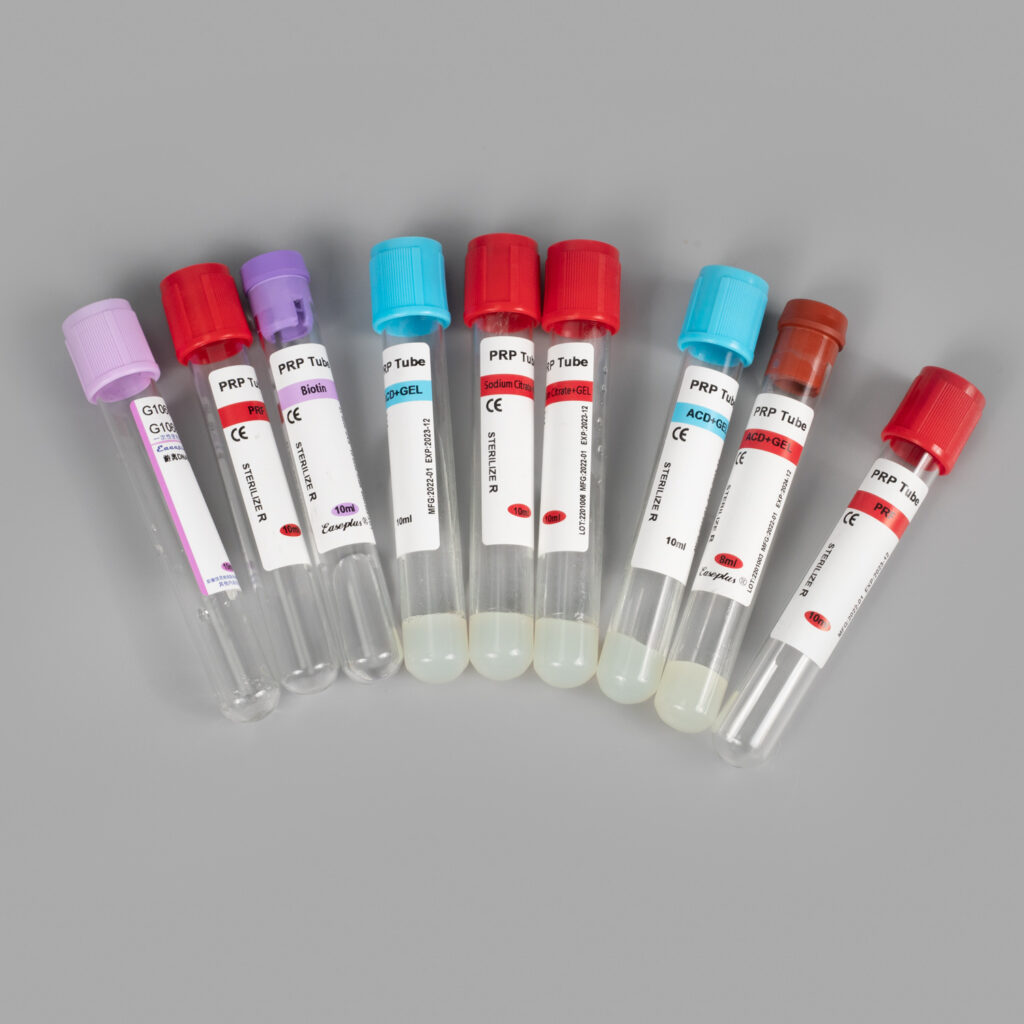
Selecting a Reliable PRP Tube Supplier
A dependable supplier is a partner in delivering safe and effective treatments. Here are the key criteria to consider when evaluating potential suppliers:
- Certifications and Regulatory Compliance: This is the most critical factor. Look for suppliers whose products have the necessary certifications, such as ISO 13485, CE marking, or FDA approval. These certifications ensure that the manufacturing processes adhere to stringent international standards for medical devices.
- Manufacturing Excellence and Quality Control: Inquire about the supplier’s manufacturing environment. Do they operate in a certified cleanroom? What are their quality control procedures? Reputable manufacturers will be transparent about their processes and provide documentation of batch traceability and sterile validation.
- Product Performance and Consistency: The supplier should provide data on the performance of their PRP tubes, including expected platelet concentration yields. Consistency from one batch to the next is crucial for reliable clinical results. Requesting samples for in-house validation is a reasonable step in the evaluation process.
- Technical Support and Expertise: A knowledgeable supplier can offer more than just a product; they provide valuable technical support. They should be able to answer detailed questions about the product’s use, recommended centrifuge protocols, and troubleshooting. This expertise is invaluable for you and your clients.
- Supply Chain Reliability: Assess the supplier’s production capacity and on-time delivery record. A supplier with a robust supply chain can prevent disruptions that could affect your business operations and your clients’ treatment schedules.
Partnering with a trusted supplier like Siny PRP not only guarantees a consistent supply of high-quality, certified PRP tubes but also enhances your reputation as a provider of superior medical products. For partnership inquiries or to learn more about our quality assurance, do not hesitate to contact us.
FAQs
1. How long does it take to see results from PRP hair treatment?
Patients may begin to notice a decrease in hair shedding within the first two sessions. Visible improvements in hair thickness and density typically appear after 3 to 6 months of consistent treatment, as the hair growth cycle is a gradual process.
2. Is PRP hair treatment painful?
Discomfort is generally minimal and temporary. Clinicians often use topical anesthetics or cooling devices to numb the scalp before the injections, making the procedure well-tolerated by most patients.
3. Who is an ideal candidate for PRP hair therapy?
PRP therapy tends to be most effective for individuals in the early stages of hair loss with areas of thinning hair, as the treatment works by stimulating existing, weakened hair follicles. It is effective for both androgenetic alopecia and alopecia areata.
4. How many PRP sessions are needed for hair loss?
A typical initial treatment protocol involves 3-4 sessions spaced 4-6 weeks apart. After the initial series, maintenance sessions are often recommended every 6 to 12 months to preserve the results.
5. Are there any side effects of PRP for hair loss?
Since PRP is derived from the patient’s own blood, the risk of allergic reactions or serious side effects is very low. Potential side effects are typically mild and localized to the injection site, including temporary pain, redness, swelling, headache, or itching.
6. Does the brand of the PRP tube really matter?
Absolutely. The quality and design of the PRP tube directly influence the platelet concentration and purity of the final PRP product. Using a high-quality, certified medical device like a Siny PRP tube is crucial for achieving the best possible clinical outcomes.
Summary
To return to our central question: Does PRP really regrow hair? The evidence overwhelmingly suggests that it can be a powerful tool in the fight against hair loss. However, its potential is only fully realized when every step of the process is optimized, beginning with the collection and preparation phase.
For laboratory professionals who prepare the plasma and for the distributors who supply the essential tools. This places a significant responsibility on your shoulders. The selection of a PRP tube is not merely a procurement decision; it is a critical contribution to the chain of clinical care. By prioritizing certified, high-performance products from a trusted manufacturer, you empower clinicians to deliver consistent, safe, and effective results. In doing so, you build trust, enhance your professional reputation, and play a vital role in the successful advancement of regenerative hair restoration. Elevate your offerings and ensure the highest standard of care by partnering with a supplier committed to excellence.

